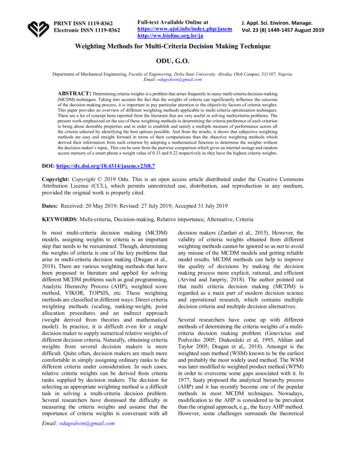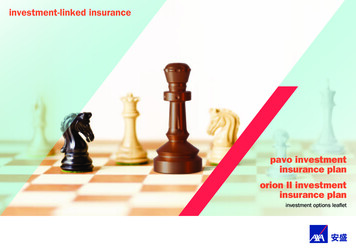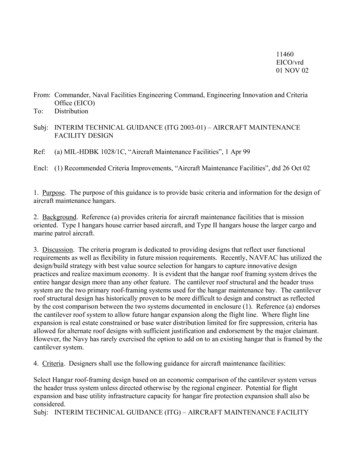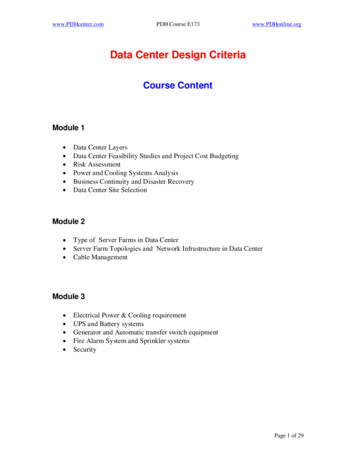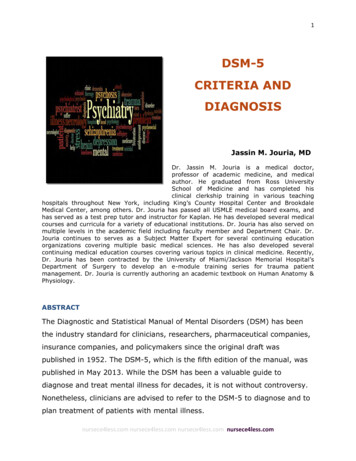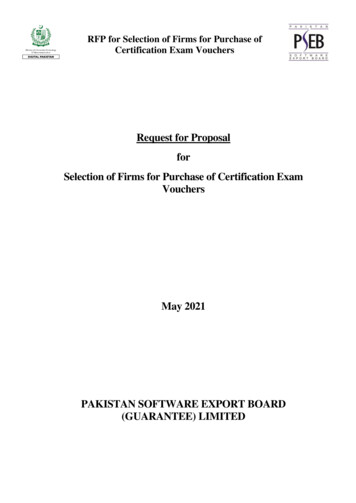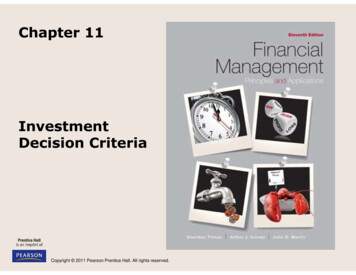
Transcription
Chapter 11InvestmentDecision CriteriaCopyright 2011 Pearson Prentice Hall. All rights reserved.
Chapter 11 Contents Learning Objectives Principles Used in This Chapter1.2.3.4.An Overview of Capital BudgetingNet Present ValueOther Investment CriteriaA Glance at Actual Capital Budgeting PracticesCopyright 2011 Pearson Prentice Hall. All rights reserved.11-2
Learning Objectives1.Understand how to identify the sources and types ofprofitable investment opportunities.2.Evaluate investment opportunities using net present valueand describe why net present value provides the bestmeasure for evaluating investments.3.Use the profitability index, internal rate of return, andpayback criteria to evaluate investment opportunities.4.Understand current business practice with respect to theuse of capital budgeting criteria.Copyright 2011 Pearson Prentice Hall. All rights reserved.11-3
Principles Used in This Chapter Principle 3: Cash Flows Are the Source of Value.– We value an investment opportunities by evaluating itsexpected cash flows. Principle 1: Money Has a Time Value.– While evaluating investment opportunities, we discountall cash flows back to the present. Principle 2: There is a Risk-Reward Tradeoff.– While evaluating investment opportunities, we factor riskinto the analysis by increasing the discount rate whilecalculating the present value of cash flows. Principle 4: Market Prices Reflect Information.– The risk adjusted discount rate used to calculate thepresent values of project’s cash flows depends upon themarket prices that reflect information.Copyright 2011 Pearson Prentice Hall. All rights reserved.11-4
Three Lessons from Disney Background– Disney’s decision to invest 17.5 million to buildDisneyland park in California is an example of capitalbudgeting decision.– Subsequently, Disney opened theme parks in Orlando,Tokyo, Paris and most recently invested 3.5 billion tobuild a theme park in Hong Kong. Today parks and resorts account for over 30% of Disney’sRevenue. Disney Lessons1.2.3.Capital budgeting decisions are critical to a firm’s success.Very large investments are frequently the result of manysmaller investment decisions that define a business strategy.Successful investment choices lead to the development ofmanagerial expertise and capabilities that influence the firm’schoice of future investments.Copyright 2011 Pearson Prentice Hall. All rights reserved.11-5
The Typical Capital Budgeting Process Phase I: The firm’s management identifiespromising investment opportunities. Phase II: The value creating potential of variousopportunities are thoroughly evaluated.– So the goal is to identify promising opportunities andselect those that will create the most value for the firm’scommon stockholders.What Are the Sources of Good Investment Projects? It is not easy to find profitable investment opportunities incompetitive markets. Good investments are most likely to be found in marketsthat are less competitive where barriers to new entrants aresufficiently high to keep out would-be competitors.Copyright 2011 Pearson Prentice Hall. All rights reserved.11-6
Types of Capital Investment Projects1)Revenue enhancing Investments (for example,entering a new market)2)Cost-reduction investments (for example, installing amore efficient equipment)3)Mandatory investments that are a result of governmentmandate (for example, installing mandatory safetyfeatures in a car)Copyright 2011 Pearson Prentice Hall. All rights reserved.11-7
Which of the following factors is least importantto capital budgeting decisions?1. The time value of money2. The risk-return tradeoff3. Net income based on accrualaccounting principles4. Cash flows directly resulting fromthe decision25%25%25%25%101Copyright 2011 Pearson Prentice Hall. All rights reserved.23411-8
Finance Tools to Assess Capital Investment Projects Before an investments is made, the firm will like to evaluatewhether it will create value. To determine the desirability of investment proposals, wecan use several analytical tools such as:– Net Present Value (NPV),– Equivalent Annual Cost (EAC),– the Profitability Index (PI),– the Internal Rate of Return (IRR),– the Modified Internal Rate of Return (MIRR),– the payback period,– and discounted payback period.Copyright 2011 Pearson Prentice Hall. All rights reserved.11-9
Net Present Value The net present value (NPV) is the differencebetween the present value of cash inflows and thecash outflows. NPV estimates the amount ofwealth that the project creates. Decision Criteria: Investment projects should beaccepted if the NPV of project is positive andshould be rejected if the NPV is negative.Copyright 2011 Pearson Prentice Hall. All rights reserved.11-10
Rationale for the NPV MethodNPV PV of inflows – Cost Net gain in wealth If projects are independent, accept if the projectNPV 0. If projects are mutually exclusive, accept projectswith the highest positive NPV, those that add themost value. In this example, accept S if mutually exclusive(NPVS NPVL), and accept both if independent.Copyright 2011 Pearson Prentice Hall. All rights reserved.11-11
Calculating an Investment’s NPV - Logic The NPV of an investment proposal can bedefined as follows: NPV PV Future Cash flows minus initialinvestmentCopyright 2011 Pearson Prentice Hall. All rights reserved.11-12
Copyright 2011 Pearson Prentice Hall. All rights reserved.11-13
Independent Versus Mutually ExclusiveInvestment Projects An independent investment project is one that standsalone and can be undertaken without influencing theacceptance or rejection of any other project. A mutually exclusive project prevents another projectfrom being accepted. Evaluating an Independent Investment Opportunity– It will require two steps:1. Calculate NPV;2. Accept the project if NPV is positive and reject if it isnegative.Copyright 2011 Pearson Prentice Hall. All rights reserved.11-14
Example 11-1Calculating the NPV for Project LongProject Long requires: An initial investment of 100,000–Is expected to generate a cash flow of 70,000 in year one, 30,000 peryear in years two and three, 25,000 in year four, and 10,000 in year 5. The discount rate (k) appropriate for calculating the NPV ofproject Long is 17 percent. Is Project Long a good investment opportunity?Copyright 2011 Pearson Prentice Hall. All rights reserved.11-15
Checkpoint 11.1Copyright 2011 Pearson Prentice Hall. All rights reserved.11-16
Solution LogicStep 3 cont.Copyright 2011 Pearson Prentice Hall. All rights reserved.11-17
Checkpoint 11.1Copyright 2011 Pearson Prentice Hall. All rights reserved.11-18
Example 11-2 Saber Electronics provides specialty manufacturingservices to defense contractors located in the Seattle,WA area. The initial outlay is 3 million Management estimates that the firm might generatecash flows for years one through five equal to 500,000; 750,000; 1,500,000; 2,000,000; and 2,000,000. Saber uses a 20% discount rate for this type of project. Is this a good investment opportunity?Copyright 2011 Pearson Prentice Hall. All rights reserved.11-19
Step 1: Picture the Problemk 20%012345YearsCash flows(in millions)- 3M 0.5M 0.75M 1.5M 2M 2MNetPresentValue ?Copyright 2011 Pearson Prentice Hall. All rights reserved.11-20
Step 2: Decide on a Solution Strategy We need to analyze if this is a good investmentopportunity. We can do that by computing theNet Present Value (NPV), which requirescomputing the present value of all cash flows. We can compute the NPV by using amathematical formula, a financial calculator or aspreadsheet.Copyright 2011 Pearson Prentice Hall. All rights reserved.11-21
Step 3: Solve Using Mathematical FormulaCopyright 2011 Pearson Prentice Hall. All rights reserved.11-22
Step 3: Solve (cont.) NPV - 3m .5m/(1.2) .75m/(1.2)2 1.5m/(1.2)3 2m/(1.2)4 2m/(1.2)5 NPV - 3,000,000 416,666.67 520,833.30 868,055.60 964,506 803,755.10 NPV 573,817PV of Cash in 416.666.67 803,755.10 3,573,817Minus Initial Investment of 3,000,000Equals NPV 573,817 which means you earn morethan 20% return.Copyright 2011 Pearson Prentice Hall. All rights reserved.11-23
Step 4: Analyze The project requires an initial investment of 3,000,000 and generates futures cash flows thathave a present value of 3,573,817. Consequently, the project cash flows are 573,817 more than the required investment. Since the NPV is positive, the project is anacceptable project. A positive NPV indicates the project earns morethan the discount rate (cost of capital)of 20%Copyright 2011 Pearson Prentice Hall. All rights reserved.11-24
ABC Service can purchase a new assembler for 15,052that will provide an annual net cash flow of 6,000 peryear for five years. Calculate the NPV of the assembler ifthe required rate of return is 12%. (Round your answer tothe nearest 1.)1. 1,0562. 4,5683. 7,6214. 6,577100%1Copyright 2011 Pearson Prentice Hall. All rights reserved.11-25
Evaluating Mutually Exclusive Investment Opportunities There are times when a firm must choose thebest project or set of projects from the set ofpositive NPV investment opportunities. These are considered mutually exclusiveopportunities as the firm cannot undertake allpositive NPV projects. Following are two situations where firm is facedwith mutually exclusive projects:1. Substitutes – Where firm is trying to pick betweenalternatives that perform the same function.2. Firm Constraints – Firm may face constraints such aslimited managerial time or financial capital that may limitits ability to invest in all the positive NPV opportunities.Copyright 2011 Pearson Prentice Hall. All rights reserved.11-26
Method: Choosing Between Mutually ExclusiveInvestments1. If mutually exclusive investments have equallives, calculate the NPVs and choose the onewith the higher NPV.2. If mutually exclusive investments do not haveequal lives, you must calculate the EquivalentAnnual Cost (EAC), the cost per year.3. Select the one that has a lower EAC.Copyright 2011 Pearson Prentice Hall. All rights reserved.11-27
Choosing Between Mutually ExclusiveInvestments (cont.) Computation of EAC requires two steps:1. Compute NPV2. Compute EAC as per equation 11-2Copyright 2011 Pearson Prentice Hall. All rights reserved.11-28
Example 11.2: Calculating the Equivalent AnnualCost (EAC)Suppose your bottling plant is in need of a new bottle capper. You are considering twodifferent capping machines that will perform equally well, but have differentexpected lives. The more expensive one costs 30,000 to buy, requires the payment of 3,000per year for maintenance and operation expenses, and will last for 5 years. The cheaper model costs only 22,000, requires operating and maintenancecosts of 4,000 per year, and lasts for only 3 years. Regardless of which machine you select, you intend to replace it at the end ofits life with an identical machine with identical costs and operating performancecharacteristics. Because there is not a market for used cappers, there will be no salvage valueassociated with either machine. Assume that the discount rate on both of these machines is 8 percent.Copyright 2011 Pearson Prentice Hall. All rights reserved.11-29
Checkpoint 11.2Copyright 2011 Pearson Prentice Hall. All rights reserved.11-30
Checkpoint 11.2Copyright 2011 Pearson Prentice Hall. All rights reserved.Step 3 cont.11-31
Checkpoint 11.2Step 3 cont.Copyright 2011 Pearson Prentice Hall. All rights reserved.11-32
Checkpoint 11.2Copyright 2011 Pearson Prentice Hall. All rights reserved.11-33
Checkpoint 11.2Copyright 2011 Pearson Prentice Hall. All rights reserved.11-34
Practice the EAC Method What is EAC for a machine that costs 50,000 requires payment of 6,000 per year formaintenance and operation expense, and lasts for 6 years? Assume that the discount rate is 9% and therewill be no salvage value associated with themachine. In addition, you intend to replace this machine atthe end of its life with an identical machine withidentical costs.Copyright 2011 Pearson Prentice Hall. All rights reserved.11-35
Step 1: Picture the Problemk 9%0123- 6- 6- 6456YearsCash flows(in , thousands)- 50- 6- 6 6EAC ?Copyright 2011 Pearson Prentice Hall. All rights reserved.11-36
Step 2: Solve Using Mathematical FormulaIt requires 2 steps:– Computation of NPV Here the cash inflows are equal so we can use theannuity equation to determine the PV of cash inflows.NPV - 50,000 PV of 6,000 each year - 50,000 - 6,000 (PV of Annuity Factor) - 50,000 - 6,000 {[1-(1/(1.09)6] (.06)} - 50,000 - 6,000 {4.4859) - 76,915Computation of EAC EAC NPV Annuity Factor - 76,915 4.4859 - 17,145.95Simpler approach would be PV -76,915; I/Y 9%, N 6, FV 0Now solve for PMT ?Copyright 2011 Pearson Prentice Hall. All rights reserved.11-37
11.3 OtherInvestmentCriteriaCopyright 2011 Pearson Prentice Hall. All rights reserved.
Profitability Index The profitability index (PI) is a cost-benefit ratio equal tothe present value of an investment’s future cash flowsdivided by its initial cost: Decision Criteria:– If PI is greater than one, it indicates that the investmentshould be accepted. The NPV will be positive.– If PI is less than one, the project should be rejected. If PIis less than one, the NPV will be negative.Copyright 2011 Pearson Prentice Hall. All rights reserved.11-39
Checkpoint 11.3Example: Calculating the Profitability IndexProject Long is expected to provide five years of cash inflows and torequire an initial investment of 100,000. The discount rate that isappropriate for calculating the PI of Project Long is 17 percent. Is ProjectLong a good investment opportunity?Copyright 2011 Pearson Prentice Hall. All rights re
Finance Tools to Assess Capital Investment Projects Before an investments is made, the firm will like to evaluate whether it will create value. To determine the desirability of investment proposals, we can use several analytical tools such as: – Net Present Value (NPV), – Equivalent Annual Cost (EAC), – the Profitability Index (PI),
